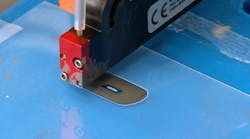Researchers at Purdue have developed a method that deposits tiny amounts of energetic materials (explosives, propellants, and pyrotechnics) using the same technology as an inkjet printer. This research combines the university’s expertise in both energetic materials and 3D printing
Many micromechanical systems incorporate energetic materials in their operation. For example, an automotive airbag deploys using a small amount of solid propellant. But as devices get smaller, the need for micro-level energetics becomes more critical.
“Our solution was to combine two components as we print them,” says Jeff Rhoads, professor of mechanical engineering, and principal investigator on the project. “We can have a fuel—aluminum—and an oxidizer—copper oxide—in two separate suspensions, which are largely inert. Then, with our custom inkjet printer, we can deposit the two in a specific overlapping pattern, combining them on a substrate to form nanothermite.”
The mount of explosives is only in the picoliters, so it was a challenge to achieve the right droplet volume and pattern. The other challenge was designing a printer that could deposit droplets accurately. The researchers’ solution was to use a tube surrounded by material that flexes when a voltage is applied. The flexing action squeezes the tube, creating picoliter droplets. Varying the voltage varies the size of the droplets and users can increase or decrease the size of the droplet in 0.1-micron increments.
The Purdue machine holds the tube and nozzle stationary and moves a stage below it to form whatever shape is required. The stage can move with 0.1 micron precision.
The resulting nanothermite reacts just as quickly and powerfully as thermites applied in traditional ways. It burns at 2,500 Kelvin (over 4,000 degrees Fahrenheit), generates a lot of thrust and heat, and makes a nice loud shockwave.

